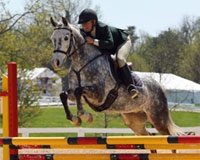
Lessons are a regular part of the lives of most equestrians, and because of this, we as riders grow accustomed to following directions given by our instructors as we travel around the arena doing schooling exercises with our horse. But what happens when you’re riding on your own?
Whether you’re familiar with the horse you’re riding or it’s a horse that is completely new to you, it will be beneficial to work on what all horses and riders need to be reminded of daily—going forward and straight.
All of the following exercises bring these concepts to the forefront and are best attempted once the horse has had a lengthy walk (10 minutes) and a lap or two to stretch out in each direction at the trot and canter. All can be ridden at the walk, trot or canter.

Centerline Schooling Exercise
The centerline is an invisible line that runs up the middle (center) of the arena, cutting it in half the long way. At the midpoint of the centerline is the letter X. X represents the location for change of bend, change of diagonal, and/or a change of lead.
In order for your horse to be straight from start to finish during this and other schooling exercises, you’ll need to maintain control of his shoulder through the turn at each end of the arena. This is accomplished by ensuring that your abdominals are engaged and that your hands are held 4 inches apart while gently lifting up and back, which prevents your horse from leaning on his forehand.
You then add your outside leg to help him swing his body onto (or off of) the centerline. Keep even contact in both reins to prevent an accidental outside bend in response to pressure from your outside leg.
 Remember to stay riding forward, since the slower a horse goes, the easier it is for him to become crooked. The centerline can be ridden as a change of direction, or you can maintain the same direction.
Remember to stay riding forward, since the slower a horse goes, the easier it is for him to become crooked. The centerline can be ridden as a change of direction, or you can maintain the same direction.

Long and Short Diagonal
The long diagonals of the arena run from corner to opposite corner and pass through X. Short diagonals go from halfway down the long side of the arena to the opposite corner, or vice versa. (See diagrams below.)
 Riding across any diagonal is always done as a change of direction. The riding principles for traveling across a diagonal are very similar to those for traveling down the centerline, with a feeling of lift in the turns and a complete focus on straightness as you move across the arena.
Riding across any diagonal is always done as a change of direction. The riding principles for traveling across a diagonal are very similar to those for traveling down the centerline, with a feeling of lift in the turns and a complete focus on straightness as you move across the arena.
During the centerline and both versions of the diagonal, you can begin to add transitions on the straightaway, working to maintain straightness, energy, and lift through each transition.
Three-Loop Serpentine With Your Horse
This figure begins and ends at either end of the centerline, crosses the centerline twice, and cuts the ring into thirds (see below).
It builds on what you have established by riding the centerlines and diagonals, but is more challenging, as the periods of straightness are shorter with the turns coming up faster. This requires increased organization in order to coordinate the turns, and when ridden in trot or canter, doing changes of diagonal or lead.
Half Turn in Reverse

This is a great way to switch up your change of direction. Most horses anticipate what they are about to be asked and are not often asked to turn toward the fence, so this is a good test of whether your horse is truly responding to your aids. (See diagram below right.)
Anywhere along the fence line, bring your horse off the rail with your outside leg. Ride a diagonal line for a few strides away from the fence, then begin shaping a half circle back toward the fence with your horse starting to bend around the new inside leg.
Because this is a change of direction maneuver, the former outside leg has now become the shaping inside leg, and the former inside leg will become the new outside leg, helping to push your horse around the turn to move forward and straight into the new direction alongside the fence.
Familiarizing yourself with these exercises is just the beginning. Allow them to become a part of your riding toolbox, trying them on a variety of horses and noting how different horses need to be supported in different ways. Soon you will become well versed at schooling any horse you ride to be forward and straight.
This article about new schooling exercises for you and your horse appeared in the January/February 2021 issue of Horse Illustrated magazine. Click here to subscribe!







